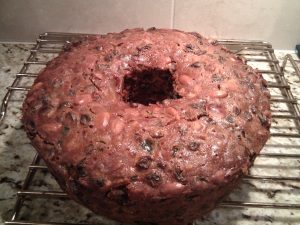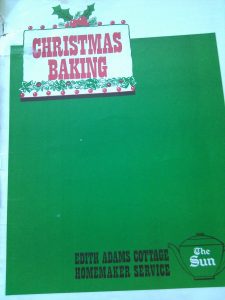 It’s a bit of a mystery how fruitcake became “Christmas Cake”. Some historians trace fruitcake to cakes that were placed in the tombs of ancient Egypt as food for the afterlife. But most credit the ancient Romans who mixed together pomegranate seeds, pine nuts and barley mash into a ring-shaped dessert so prized for its portability and shelf life it was often brought by soldiers to sustain them during battle.
It’s a bit of a mystery how fruitcake became “Christmas Cake”. Some historians trace fruitcake to cakes that were placed in the tombs of ancient Egypt as food for the afterlife. But most credit the ancient Romans who mixed together pomegranate seeds, pine nuts and barley mash into a ring-shaped dessert so prized for its portability and shelf life it was often brought by soldiers to sustain them during battle.
Over the ages fruitcake has had many iterations but still retains the common ingredients of fruits and nuts held together by some form of batter or dough. Spices, preserved fruit and honey were added in the Middle Ages. The preserved fruit was either dried (as in raisins, figs, dates) or candied by soaking in high concentrations of sugar. These processes allowed for tropical fruits to be accessible in northern countries where regional variations of the cake appeared, for example, panforte in Italy, stollen in Germany.
By the 18th and 19th century, fruitcake was considered an indulgence due to the high cost of the ingredients. In fact it was outlawed for a period of time in 18th century England as it was proclaimed “sinfully rich” with the only exception being certain holidays including Christmas. The ban went by the wayside when it became popular in the Victorian era as a key sweet for a Victorian-style “Tea”. By this time the making of fruit cake had become more complex, requiring investment in costly ingredients and preparation time. The cakes were often wrapped and re-wrapped, in rum- or brandy-soaked cheesecloth, for months in advance of the holidays.
There are various theories about how fruitcake became tied to the holiday season. Some believe it is because the bread originated in the Holy Land while others believe it was because English citizens passed out fruitcake slices to the poor women who sang Christmas carols on the streets of London in the late 1700s. Whatever the reason, it has become a standard (at times much maligned) for the holiday season.
Two New Zealand authors did an analysis of cookbooks in their country for an article called The Archaeology of Christmas Cake (Leach & Inglis, 2003). They noted that the recipes changed depending on the socio-economic times with Christmas cakes in the first decade of the 20th Century having less fruit, more flour, butter and eggs. When times became better in the 1920s, more expensive ingredients such as more dried fruit, imported nuts, and brandy were added. In the Great Depression of the 1930s less butter, sugar, eggs, brandy and almonds were used. Rationing during World War II resulted in eggless recipes that used lard rather than butter, and walnuts replacing almonds. In the 1950s the proportion of fruit rose but the size of the cakes declined. By the 1960s and 70s a wider range of ingredients appeared with less flour. Then by 1990s with the decline in home baking, fewer recipes were evident. Since we share a similar colonial history to New Zealand, it would be interesting to conduct a similar study with BC cookbooks.
In Canada, the traditional fruit cake is rarely eaten outside the holiday season. My Canadian version is similar to the dark, moist, fruit-filled British version. I usually make it in early November and then wrap it with cheesecloth soaked in brandy, plastic wrap and aluminum foil, and don’t open until Christmas. I often make several and keep some in the freezer, taking them out the following November, renewing the cheesecloth by soaking in more brandy and keeping the cakes at room temperature until the holiday season.
I don’t remember where the recipe originally came from but over the years I have tweaked the fruit a bit. The original recipe had a large amount of dates which we didn’t care for so I reduced that ingredient and replaced with other fruit. One year I tried to make it mostly out of BC ingredients, replacing the almonds with hazelnuts, the corn syrup with local honey, and using mostly BC dried fruits.
 There are endless recipes for fruitcake, some dark with molasses or brown sugar, and spices, and some light with a white cake base with diverse ingredients and cultural variations. In the early 1980s Edith Adams Cottage Homemaker Service of the Vancouver Sun published an updated version of its Christmas Baking cookbook. It has no less than 57 Christmas Cake recipes (26 dark; 13 light; 14 that only need 2 weeks aging; 4 last minute fruitcakes) which leads me to believe that this tradition was alive and well in British Columbia at that time. Is it still alive in your household?
There are endless recipes for fruitcake, some dark with molasses or brown sugar, and spices, and some light with a white cake base with diverse ingredients and cultural variations. In the early 1980s Edith Adams Cottage Homemaker Service of the Vancouver Sun published an updated version of its Christmas Baking cookbook. It has no less than 57 Christmas Cake recipes (26 dark; 13 light; 14 that only need 2 weeks aging; 4 last minute fruitcakes) which leads me to believe that this tradition was alive and well in British Columbia at that time. Is it still alive in your household?
References:
Douglas, Julie (n.d.) “Ultimate Guide to Fruit Cake”, How stuff works lifestyle online. Retrieved from http://recipes.howstuffworks.com/menus/fruitcake1.htm
Leach, Helen M. & Inglis, Raelene (2003). The archaeology Of Christmas Cakes, Food & Foodways, 11, 141–166.

I haven’t seen it written about or researched but in my home town in Manitoba in1950 and 1960s, wedding cakes were usually three layer creations that were all fruit cake. Wedding cakes these days don’t seem to be fruit cakes but for a time they were??
Yes much of the research on fruitcakes indicates that about the same time it became common for Christmas it was also used as wedding cake. It is probably because the ingredients were expensive and the cake a rare indulgence for a special occasion. So for most of the 18th, 19th and for most of 20th century traditionally wedding cakes were fruitcakes (at least in most European and countries with a colonial heritage). There were various customs around the wedding cake, for example, in England unmarried wedding guests were to put a slice of the cake under their pillow at night so they will dream of the person they will marry; or the top layer of the cake was saved to be eaten on an anniversary (first? tenth?). Fruitcake as wedding cake in North America fell out of favour in the latter part of the 20th century as tastes changed and a preference for other lighter cakes prevailed.
Oh my!!! I have been going crazy trying to locate my copy of Edith’s Adam Christmas Baking! I particularly use it for the fruit cake recipes, and the thorough instructions for preparing the tins before baking. Invaluable were her baking times using the traditional 3 set of Christmas cake tins which I like to use.
Sadly, my copy has gone missing. Do you know of any I might be able to purchase a copy? I have searched in every possible nook and cranny of my home to no avail.
Thank you for your time.
When I wrote the blog, I did find a few copies for sale when I did a google search but I am not finding any now. We have had some success in finding old cookbooks at thrift stores and second hand book stores. You could also try your local library. I have packed my book away so can’t access it at the moment but if I recall correctly preparing the pans involved cutting 2 pieces brown paper to fit the bottom on the pan and greasing them liberally.
I have Edith Adams’ Christmas Baking Book – it doesn’t look like I can attach the information here. I will send the pages you want to the email you posted from.
is there any way you could email the recipe for Edith Adams Dark Christmas Fruit Cake ? I lost my Christmas Baking book (the green one) that the Vancouver Sun sent me a long time ago …. Thank you and Happy Holidays Stay safe !
Valerie Strong
Yes I will scan and send.
Would you be able to please email me a copy too? My grandma lost hers in a move and it is her tried and true Christmas fruitcake recipe. Thanks so much!
Michele
Hello, could you possibly send me the recipe for Edith Adams dark Christmas cake? I made it regularly every year and for several weddings. But – lost it during a decluttering episode!!
Thanks so much
I used to have this Edith Adams Christmas Baking Book…and I lost it in a move…fabulous recipes for fruitcakes…
Often these blogs stir memories and such it is with fruit cakes – our wedding cake (early 70’s) was fruit cake – the decorator didn’t like icing fruit cake – maybe because it was the summer so she piped little strands of icing on fingers of fruit cake and we put them in little boxes. Oh my, how times have changed.
When I got married the top layer was supposed to be kept for one of the anniversaries. It survived many moved but in the end got lots so we never did find out how well it kept.
For additional information on fruitcakes you might want to refer to Gerard Paul’s post at ManyEats,